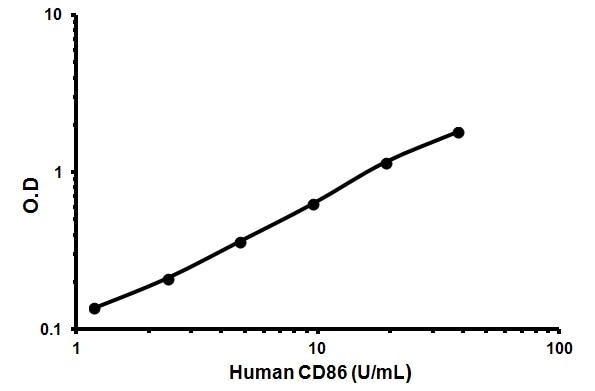Human CD86 ELISA Kit (ab45921)
Key features and details
- Sensitivity: 0.6 U/ml
- Range: 1.187 U/ml - 38 U/ml
- Sample type: Cell culture supernatant, Plasma, Serum
- Detection method: Colorimetric
- Assay type: Sandwich (quantitative)
- Reacts with: Human
Overview
-
Product name
Human CD86 ELISA Kit
See all CD86 kits -
Detection method
Colorimetric -
Precision
Intra-assay Sample n Mean SD CV% Sample A 8 37.25U/ml 0.329 0.88% Sample B 8 5.09U/ml 0.193 3.79% Inter-assay Sample n Mean SD CV% Sample A 39 37.63U/ml 0.611 1.62% Sample B 39 4.92U/ml 0.348 7.06% -
Sample type
Cell culture supernatant, Serum, Plasma -
Assay type
Sandwich (quantitative) -
Sensitivity
= 0.6 U/ml -
Range
1.187 U/ml - 38 U/ml -
Assay time
2h 40m -
Assay duration
Multiple steps standard assay -
Species reactivity
Reacts with: Human -
Product overview
Abcam’s Human CD86 in vitro ELISA (Enzyme-Linked Immunosorbent Assay) kit is designed for the quantitative measurement of CD86 in Human serum, plasma, buffered solutions or cell culture medium.
A monoclonal antibody specific for CD86 has been coated onto the wells of the microtiter strips provided. Samples, including standards of known CD86 concentrations, control specimens or unknowns are pipetted into these wells. During the first incubation, the standards or samples and a biotinylated monoclonal antibody specific for CD86 are simultaneously incubated. After washing, the enzyme Streptavidin-HRP, that binds the biotinylated antibody is added, incubated and washed. A TMB substrate solution is added which acts on the bound enzyme to induce a colored reaction product. The intensity of this colored product is directly proportional to the concentration of CD86 present in the samples.
This kit will recognize both endogenous and recombinant Human CD86.
-
Platform
Microplate
Properties
-
Storage instructions
Store at +4°C. Please refer to protocols. -
Components Identifier 2 x 96 tests 1 x 96 tests 10X Standard Diluent Buffer Black 1 x 25ml 1 x 15ml 200X Wash Buffer White 2 x 10ml 1 x 10ml Biotinylated Antibody Diluent Red 1 x 13ml 1 x 7ml Biotinylated anti-CD86 Red 2 x 0.4ml 1 x 0.4ml CD86 Microplate (12 x 8 well strips) 2 units 1 unit CD86 Standard (Lyophilized) Yellow 4 vials 2 vials Chromogen TMB Substrate Solution 1 x 24ml 1 x 11ml HRP Diluent Red 1 x 23ml 1 x 12ml Stop Reagent Black 2 x 11ml 1 x 11ml Streptavidin-HRP 4 x 5µl 2 x 5µl -
Research areas
-
Function
Receptor involved in the costimulatory signal essential for T-lymphocyte proliferation and interleukin-2 production, by binding CD28 or CTLA-4. May play a critical role in the early events of T-cell activation and costimulation of naive T-cells, such as deciding between immunity and anergy that is made by T-cells within 24 hours after activation. Isoform 2 interferes with the formation of CD86 clusters, and thus acts as a negative regulator of T-cell activation. -
Tissue specificity
Expressed by activated B-lymphocytes and monocytes. -
Sequence similarities
Contains 1 Ig-like C2-type (immunoglobulin-like) domain.
Contains 1 Ig-like V-type (immunoglobulin-like) domain. -
Post-translational
modificationsPolyubiquitinated; which is promoted by MARCH8 and results in endocytosis and lysosomal degradation. -
Cellular localization
Membrane. - Information by UniProt
-
Alternative names
- Activation B7-2 antigen
- Activation B7-2 antigen 3
- B-lymphocyte activation antigen B7-2
see all -
Database links
- Entrez Gene: 942 Human
- Omim: 601020 Human
- SwissProt: P42081 Human
- Unigene: 171182 Human
Images
-
CD86 in U937 lysates from control cells or cells stimulated for 24 hours with 50 ng x mL-1 PMA (ab120297) or PMA with 1 ug x mL-1 LPS for the last 6 hours (duplicates; +/- SD).
2e6 snap frozen cells were lysed in 0.3 mL RIPA lysis buffer on ice, sonicated in an ice cold water bath for 12 intervals for a total of 3.5 minutes. The supernatants were cleared by centrifugation (max speed, 10 minutes, 4 degrees), and tested undiluted or diluted 1/4.
-
CD86 measured in undiluted 72 hours culture supernatants from control of treated (5 ug x mL-1 PHA; Sigma) PBMCs (1e6 cells x mL-1; duplicates +/- SD).
-
Standard curve with background signal subtracted (duplicates; +/- SD).
-
Representative Standard Curve using ab45921













